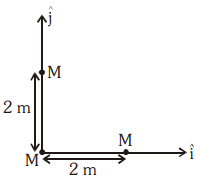A uniform square plate ABCD has a mass of 10 kg.
If two point masses of 5 kg each are placed at the corners C and D as shown in the adjoining figure, then the centre of mass shifts to the mid-point of:
1. OH
2. DH
3. OG
4. OF
The mass per unit length of a non-uniform rod of length L is given by where is a constant and x is the distance from one end of the rod. The distance between the centre of mass of the rod and this end is:
1.
2.
3.
4.
The centre of the mass of 3 particles, 10 kg, 20 kg, and 30 kg, is at (0, 0, 0). Where should a particle with a mass of 40 kg be placed so that its combined centre of mass is (3, 3, 3)?
1. (0, 0, 0)
2. (7.5, 7.5, 7.5)
3. (1, 2, 3)
4. (4, 4, 4)
Five uniform circular plates, each of diameter D and mass m, are laid out as shown in the figure. Using the origin shown, the y co–ordinate of the centre of mass of the five–plate system will be:

| 1. | 2D/5 | 2. | 4D/5 |
| 3. | D/3 | 4. | D/5 |
A man of 50 kg mass is standing in a gravity free space at a height of 10 m above the floor. He throws a stone of 0.5 kg mass downwards with a speed of When the stone reaches the floor, the distance of the man above the floor will be:
| 1. | 9.9 m | 2. | 10.1 m |
| 3. | 10 m | 4. | 20 m |
At t = 0, the positions of the two blocks are shown. There is no external force acting on the system. Find the coordinates of the center of mass of the system at t = 3 seconds:
| 1. | (1, 0) | 2. | (3, 0) |
| 3. | (4.5, 0) | 4. | (2.25, 0) |
Three identical spheres, each of mass M, are placed at the corners of a right-angle triangle with mutually perpendicular sides equal to 2m (see figure). Taking the point of intersection of the two mutually perpendicular sides as the origin, find the position vector of the centre of mass.

| 1. | \(2( \hat{i}+ \hat{j})\) | 2. | \(( \hat{i}+ \hat{j})\) |
| 3. | \({2 \over 3}( \hat{i}+ \hat{j})\) | 4. | \({4 \over 3}( \hat{i}+ \hat{j})\) |
A boat of length 10 m and a mass of 450 kg is floating without motion in still water. A man of 50 kg standing at one end walks to the other end and comes to a stop. The magnitude of the displacement of the boat relative to the ground is:
| 1. | Zero | 2. | 1 m |
| 3. | 2 m | 4. | 5 m |




